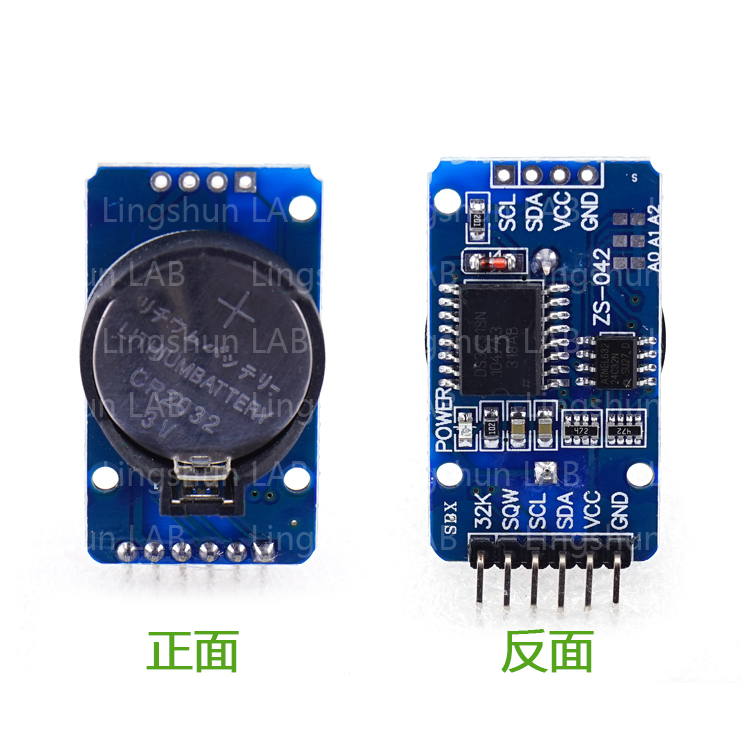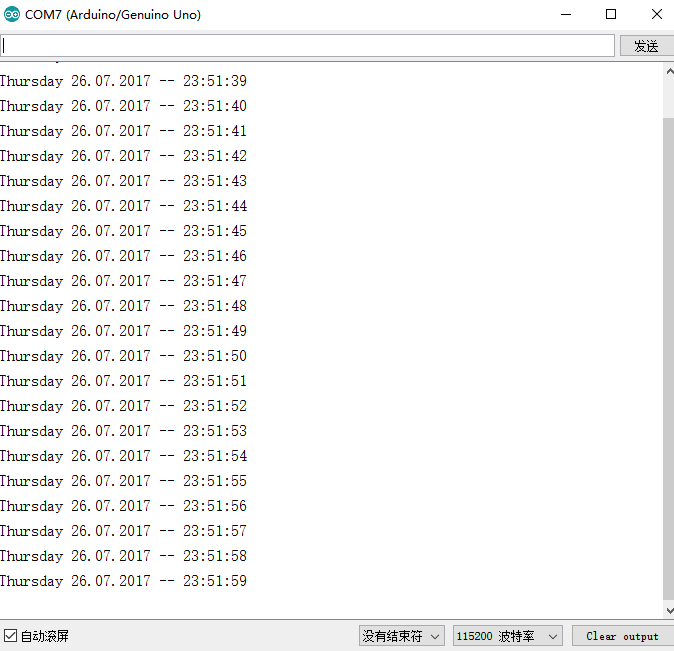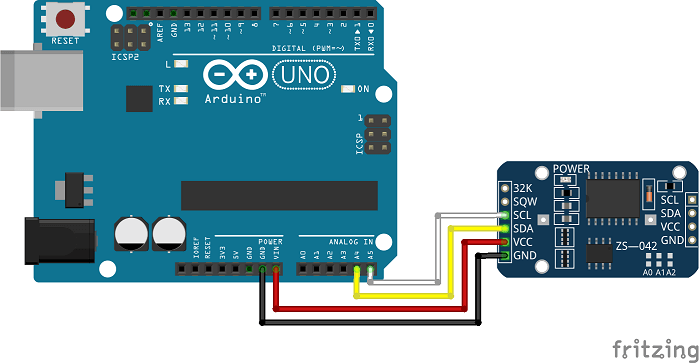Arduino UNO DS3231高精度RTC晶片 製作時鐘
DS3231 模組
是一個時鐘模組,上面包含一個鈕釦電池位置,可以在主機斷電的情況下還可以繼續計算時間,以便以後記錄使用。
模組引數:
1.尺寸:38mm(長)*22mm(寬)*14mm(高)
2.重量:8g
3.工作電壓:3.3--5.5V
4.時鐘晶片:高精度時鐘晶片DS3231
5.時鐘精度:0-40℃範圍內,精度2ppm,年誤差約1分鐘
6.帶2個日曆鬧鐘
7.可程式設計方波輸出
8.實時時鐘產生秒、分、時、星期、日期、月和年計時,並提供有效期到2100年的閏年補償
9.晶片內部自帶溫度感測器,精度為±3℃
10.儲存晶片:AT24C32(儲存容量32K)
11.IIC匯流排介面,最高傳輸速度400KHz(工作電壓為5V時)
12.可級聯其它IIC裝置,24C32地址可通過短路A0/A1/A2修改,預設地址為0x57
13.帶可充電電池LIR2032,保證系統斷電後,時鐘任然正常走動
實驗效果
通過設定時間的程式後,
我們執行顯示時間的程式,就可以看到時鐘模組當前的時間了
BOM表
Arduino UNO *1
DS3231 時鐘模組 *1
跳線若干
接線
Arduino Uno DS3231
GND <---> GND
5V <---> VCC
A4(SDA) <---> SDA
A5 (SCL) <---> SCL
程式
需要下載庫
設定時間的程式
// DS3231_Serial_Easy
// Copyright (C)2015 Rinky-Dink Electronics, Henning Karlsen. All right reserved
// web: http://www.RinkyDinkElectronics.com/
//
// A quick demo of how to use my DS3231-library to
// quickly send time and date information over a serial link
//
// To use the hardware I2C (TWI) interface of the Arduino you must connect
// the pins as follows:
//
// Arduino Uno/2009:
// ----------------------
// DS3231: SDA pin -> Arduino Analog 4 or the dedicated SDA pin
// SCL pin -> Arduino Analog 5 or the dedicated SCL pin
//
// Arduino Leonardo:
// ----------------------
// DS3231: SDA pin -> Arduino Digital 2 or the dedicated SDA pin
// SCL pin -> Arduino Digital 3 or the dedicated SCL pin
//
// Arduino Mega:
// ----------------------
// DS3231: SDA pin -> Arduino Digital 20 (SDA) or the dedicated SDA pin
// SCL pin -> Arduino Digital 21 (SCL) or the dedicated SCL pin
//
// Arduino Due:
// ----------------------
// DS3231: SDA pin -> Arduino Digital 20 (SDA) or the dedicated SDA1 (Digital 70) pin
// SCL pin -> Arduino Digital 21 (SCL) or the dedicated SCL1 (Digital 71) pin
//
// The internal pull-up resistors will be activated when using the
// hardware I2C interfaces.
//
// You can connect the DS3231 to any available pin but if you use any
// other than what is described above the library will fall back to
// a software-based, TWI-like protocol which will require exclusive access
// to the pins used, and you will also have to use appropriate, external
// pull-up resistors on the data and clock signals.
//
#include <DS3231.h>
// Init the DS3231 using the hardware interface
DS3231 rtc(SDA, SCL);
void setup()
{
// Setup Serial connection
Serial.begin(115200);
// Uncomment the next line if you are using an Arduino Leonardo
//while (!Serial) {}
// Initialize the rtc object
rtc.begin();
// The following lines can be uncommented to set the date and time
rtc.setDOW(WEDNESDAY); // Set Day-of-Week to SUNDAY
rtc.setTime(12, 0, 0); // Set the time to 12:00:00 (24hr format)
rtc.setDate(1, 1, 2014); // Set the date to January 1st, 2014
}
void loop()
{
// Send Day-of-Week
Serial.print(rtc.getDOWStr());
Serial.print(" ");
// Send date
Serial.print(rtc.getDateStr());
Serial.print(" -- ");
// Send time
Serial.println(rtc.getTimeStr());
// Wait one second before repeating :)
delay (1000);
} 顯示時間的程式
// DS3231_Serial_Easy
// Copyright (C)2015 Rinky-Dink Electronics, Henning Karlsen. All right reserved
// web: http://www.RinkyDinkElectronics.com/
//
// A quick demo of how to use my DS3231-library to
// quickly send time and date information over a serial link
//
// To use the hardware I2C (TWI) interface of the Arduino you must connect
// the pins as follows:
//
// Arduino Uno/2009:
// ----------------------
// DS3231: SDA pin -> Arduino Analog 4 or the dedicated SDA pin
// SCL pin -> Arduino Analog 5 or the dedicated SCL pin
//
// Arduino Leonardo:
// ----------------------
// DS3231: SDA pin -> Arduino Digital 2 or the dedicated SDA pin
// SCL pin -> Arduino Digital 3 or the dedicated SCL pin
//
// Arduino Mega:
// ----------------------
// DS3231: SDA pin -> Arduino Digital 20 (SDA) or the dedicated SDA pin
// SCL pin -> Arduino Digital 21 (SCL) or the dedicated SCL pin
//
// Arduino Due:
// ----------------------
// DS3231: SDA pin -> Arduino Digital 20 (SDA) or the dedicated SDA1 (Digital 70) pin
// SCL pin -> Arduino Digital 21 (SCL) or the dedicated SCL1 (Digital 71) pin
//
// The internal pull-up resistors will be activated when using the
// hardware I2C interfaces.
//
// You can connect the DS3231 to any available pin but if you use any
// other than what is described above the library will fall back to
// a software-based, TWI-like protocol which will require exclusive access
// to the pins used, and you will also have to use appropriate, external
// pull-up resistors on the data and clock signals.
//
#include <DS3231.h>
// Init the DS3231 using the hardware interface
DS3231 rtc(SDA, SCL);
void setup()
{
// Setup Serial connection
Serial.begin(115200);
// Uncomment the next line if you are using an Arduino Leonardo
//while (!Serial) {}
// Initialize the rtc object
rtc.begin();
// The following lines can be uncommented to set the date and time
//rtc.setDOW(WEDNESDAY); // Set Day-of-Week to SUNDAY
//rtc.setTime(12, 0, 0); // Set the time to 12:00:00 (24hr format)
//rtc.setDate(1, 1, 2014); // Set the date to January 1st, 2014
}
void loop()
{
// Send Day-of-Week
Serial.print(rtc.getDOWStr());
Serial.print(" ");
// Send date
Serial.print(rtc.getDateStr());
Serial.print(" -- ");
// Send time
Serial.println(rtc.getTimeStr());
// Wait one second before repeating :)
delay (1000);
}思路講解
1,#include <DS3231.h> //載入DS3231庫
2,DS3231 rtc(SDA, SCL); //設定I2C
3,rtc.begin(); //建立RTC物件
4,
rtc.setDOW(WEDNESDAY); // 設定星期幾,例如 SUNDAY
rtc.setTime(12, 0, 0); // 設定時間 12:00:00 (24小時制)
rtc.setDate(1, 1, 2014); // 設定日期 1月,1日 ,2014 年
如果在顯示程式中,或不需要設定時間的時候,可以在前面加//給註釋掉
5,
rtc.getDOWStr() 獲取星期幾
rtc.getDateStr() 獲取日期
rtc.getTimeStr() 獲取時間



